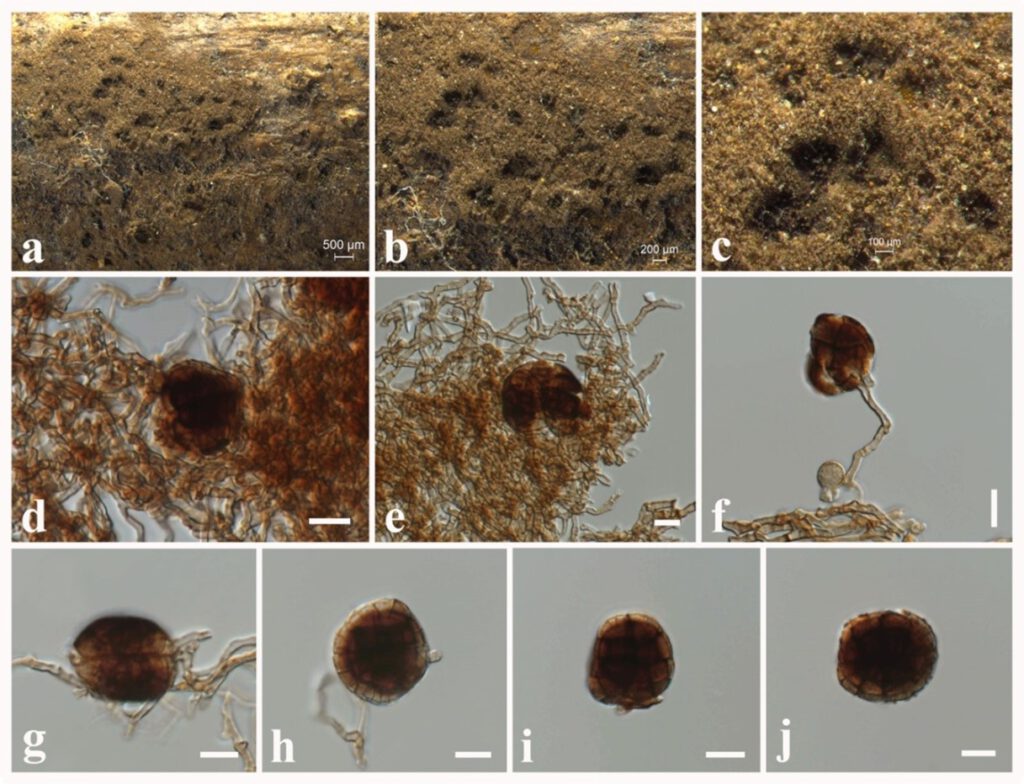Hermatomyces sphaericus (Sacc.) S. Hughes, Mycol. Pap. 50: 100 (1953)
MycoBank number: MB 298410; Index Fungorum number: IF 298410; Facesoffungi number: FoF 05259; Fig. **
Saprobic on dead twigs attached to Anomianthus dulcis. Sexual morph: Undetermined. Asexual morph: Conidiomata sporodochial, dark brown to black, circular or oval, pulvinate, often confluent, superficial, consisting of a well-developed, velvety, dense, thick, annular, dark brown sterile mycelial outer zone. Mycelium superficial, composed of a compact network of branched, septate, smooth or finely verrucose, thick-walled, brown hyphae. Conidiophores up to 35 long, 2-3 wide, micronematous, mononematous, cylindrical, pale brown, often corresponding to conidiogenous cells. Conidia one type, solitary, dry, lenticular. Lenticular conidia 23–29 × 22–27 μm ( = 27 × 25 µm, n = 30), globose, subglobose, muriform, smooth or verruculose, central cells brown, dark brown to blackish brown, sometimes all cells brown and muriform septation visible, outer ring of peripheral cells narrow or wide, pale brown to brown, often constricted at septa.
Culture characteristics – Colonies on PDA reaching 25 mm diameter after 3 weeks at 25°C, colonies from above: circular, margin entire, dense, surface smooth, white at the margin, pale brown in the centre; reverse: cream at the margin, brown in the centre.
Material examined – THAILAND, Chiang Rai Province, dead twigs attached to Anomianthus dulcis (Annonaceae), 4 April 2019, N. I. de Silva, AND5 (MFLU 21-0222), living culture, MFLUCC 21-0194, dead twigs attached to Alstonia scholaris (Apocynaceae), 25 April 2019, N. I. de Silva, AS16A (MFLU 21-0223), living culture, MFLUCC 21-0209, AS16B living culture, MFLUCC 21-0210.
Known hosts and distribution – Hermatomyces sphaericus occurring on numerous host plants and distributed in worldwide including from on decorticated branches of Barleria cristata (Acanthaceae) in Philipines (Saccardo 1917), on bark of Albizia gummifera (Mimosaceae), Averrhoa carambola (Oxalidaceae), Theobroma cacao (Sterculidaceae), and rachides of leaves of Elais guineensis (Arecaceae) collected in Ghana (Koukol et al. 2018), on fallen twigs and branches of angiosperms and on a palm petiole in Mexico (Heredia et al. 1997), on dead branch of Rauvolfia vomitoria (Apocynaceae) and dead wood of Tectona grandis (Lamiaceae) in China (Zhang et al. 2009), on dry thin branches of Larix sibirica (Pinaceae) in Russia (Mel’nik 2000).
GenBank numbers – (AND5): LSU: OK655814, ITS: OL413434, tef1: ********, (AS16A): LSU: OK655815, ITS: OL413435, tef1: ********, (AS16B): LSU: OK655816, ITS: OL413436, tef1: ********.
Notes – The type of Hermatomyces sphaericus (as Stemphylium sphaericum) was described on decorticated branches of Barleria cristata (Acanthaceae) in Philipines (Saccardo 1917). Hughes (1953) synonymized Stemphylium sphaericum as Hermatomyces sphaericus. The phylogenetic treatment of Phukhamsakda et al. (2020) was followed for Hermatomyces sphaericus in this study. During our investigation, three strains with brown, globose, subglobose, muriform lenticular conidia were isolated on dead twigs attached to host plant of Anomianthus dulcis (Annonaceae) and Alstonia scholaris (Apocynaceae) in Thailand. We recognized these three strains belong to Hermatomyces sphaericus based on morphology and phylogeny of combined LSU, ITS, tef1 and rpb2 sequence data (Fig. **). Thus, new collections were recorded as new host records of Anomianthus dulcis (Annonaceae) and Alstonia scholaris (Apocynaceae) in Thailand herein.

Figure * – Hermatomyces sphaericus (MFLU 21-0222) a–c Colonies on substrate. d, e Conidia with mycelia. f Conidiophore with conidia. g–j Conidia. Scale bars: a = 500 μm, b = 200 μm, c = 100 μm, d–j = 10 μm.
